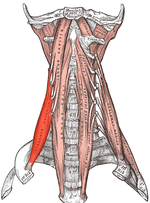Scalenus anterior muscle
| Scalenus anterior muscle |
|---|

|
| Human deep neck muscles (anterior scalene muscle only shown on the left) |
| origin |
| Proc. transversus of the 3rd-6th centuries Cervical vertebra |
| approach |
| 1st rib |
| function |
| Pulling the neck down and sideways, raising the upper rib to inhale |
| Innervation |
| Direct branches from the cervical plexus and brachial plexus |
| Spinal segments |
| C3-C6 |
The anterior scalenus muscle ( Latin for " anterior rib support muscle"; scalenus, Latin: oblique, unequal-sided), known in animals as the ventral scalenus muscle , is a skeletal muscle in the depths of the neck, which is connected by the transverse processes of the 3rd to 6th centuries. Cervical vertebra to the first rib ( tuberculum musculi scaleni anterioris ). In predators , the muscle is not developed. The anterior scalenus muscle pulls the neck to the side when it contracts on one side; when the muscles on both sides contract, the neck is pulled downwards. With the neck fixed, it lifts the first rib and thus supports inhalation.
The blood supply is in humans on the artery cervical ascending , vertebral artery , deep cervical artery and inferior thyroid artery .
The brachial plexus and, in humans, the subclavian artery, enter the axilla between the anterior scalenus muscle and the medius scalenus muscle ("posterior scalenus gap") . The posterior gap in the scalenus is usually palpable in living people, and it is usually more prominent when inhaled deeply.
Musculus scalenus anterior and Musculus sternocleidomastoideus form the " anterior scalenus gap ". The subclavian vein runs through it in a medial direction in order to unite at the vein angle with the internal jugular vein to form the brachiocephalic vein .
Clinical significance
When the (mostly posterior) gap in the scalena narrows, a scalene syndrome occurs . Pressure on the pulling brachial plexus causes pain on the inside of the forearm and the little finger side of the hand. In addition, the blood flow to the artery concerned ( subclavian artery ) is impaired, the blood pressure may be low and lead to a blue discoloration ( cyanosis ).
In interscalene blockade , a regional anesthetic procedure , the brachial plexus in the posterior scalenus gap is anesthetized, which enables surgical interventions on the arm and shoulder and, after the operation, effective pain therapy.
See also
Individual evidence
- ^ A b Franz-Viktor Salomon et al .: Anatomy for veterinary medicine. 2nd ext. Edition. Enke, Stuttgart 2008, ISBN 978-3-8304-1075-1 , p. 175.
- ↑ a b c Bernhard Tillmann : Atlas of the anatomy . 2nd Edition. Springer-Verlag, 2010, ISBN 978-3-642-02680-5 , p. 567.
- ^ Gisela Meier, Johannes Büttner: Atlas of peripheral regional anesthesia: anatomy - sonography - anesthesia - pain therapy . 3. Edition. Georg Thieme Verlag, 2013, ISBN 978-3-13-170093-3 , p. 58.
- ↑ Johannes W. Rohen: Topographische Anatomie: Textbook with special consideration of the clinical aspects and the imaging procedures . Schattauer Verlag, 2008, ISBN 978-3-7945-2616-1 , p. 233.
- ↑ John P. Patten: Neurological differential diagnosis . 2nd Edition. Springer-Verlag, 2013, ISBN 978-3-642-80379-6 , pp. 313-314.
- ^ Gisela Meier, Johannes Büttner: Atlas of peripheral regional anesthesia: anatomy - sonography - anesthesia - pain therapy . 3. Edition. Georg Thieme Verlag, 2013, ISBN 978-3-13-170093-3 , p. 59.